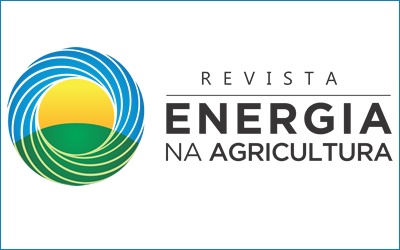DISCRIMINAÇÃO DE CLASSES DE COBERTURA VEGETAL UTILIZANDO TÉCNICAS DE CLASSIFICAÇÃO DIGITAL DE IMAGENS DE SENSORIAMENTO REMOTO
DOI:
https://doi.org/10.17224/EnergAgric.2010v25n1p152-170Resumo
Este trabalho teve por objetivo a discriminação de classes de cobertura vegetal em imagens de sensoriamento remoto do satélite CBERS-2, relativas aos períodos de inverno e de verão da região dos Campos Gerais, no Estado do Paraná. A cobertura vegetal da região apresenta diferentes culturas de inverno e de verão, além de áreas de reflorestamento, pastagem e mata natural. Foram avaliadas as técnicas de classificação supervisionada Árvore de Decisão e Máxima Verossimilhança (MAXVER), a partir de um conjunto de atributos composto por: bandas do sensor CCD (1, 2, 3 e 4), índices de vegetação (CTVI, DVI, GEMI, NDVI, SR, SAVI, TVI), modelo de mistura (solo, sombra, vegetação) e componentes principais. A avaliação da acurácia dos classificadores foi feita com base na matriz de erros de classificação e no coeficiente kappa. Na definição das classes, buscou-se um alto nível discriminatório a fim de permitir a separação dos diferentes tipos de culturas presentes na região nas épocas de inverno e de verão. A classificação por Árvore de Decisão apresentou uma acurácia total de 94,5% e coeficiente kappa igual a 0,9389, para a cena 157/128; para a cena 158/127, apresentou os valores 88% e 0,8667, respectivamente. A classificação MAXVER apresentou uma acurácia total de 84,86% e coeficiente kappa igual a 0,8099, para a cena 157/128; para a cena 158/127, apresentou os valores 77,90% e 0,7476, respectivamente. Os resultados demonstraram que o desempenho do classificador Árvore de Decisão foi superior ao do MAXVER, especialmente para as classes relativas às culturas, indicando a sua aplicação para a obtenção do mapeamento da cobertura vegetal incluindo diferentes tipos de culturas.
Palavras-chave: Árvores de decisão, máxima verossimilhança, processamento de imagens digitais.
DISCRIMINATION OF VEGETATION COVER CLASSES USING DIGITAL IMAGE TECHNIQUES AND REMOTE SENSING IMAGE
SUMMARY: The aim of this work is to discriminate vegetation classes throught remote sensing images from the satellite CBERS-2, related to winter and summer seasons in the Campos Gerais region Paraná State, Brazil. The vegetation cover of the region presents different kinds of vegetations: summer and winter cultures, reforestation areas, natural areas and pasture. Supervised classification techniques like Maximum Likelihood Classifier (MLC) and Decision Tree were evaluated, considering a set of attributes from images, composed by bands of the CCD sensor (1, 2, 3, 4), vegetation indices (CTVI, DVI, GEMI, NDVI, SR, SAVI, TVI), mixture models (soil, shadow, vegetation) and the two first main components. The evaluation of the classifications accuracy was made using the classification error matrix and the kappa coefficient. It was defined a high discriminatory level during the classes definition, in order to allow separation of different kinds of winter and summer crops. The classification accuracy by decision tree was 94.5% and the kappa coefficient was 0.9389 for the scene 157/128. For the scene 158/127, the values were 88% and 0.8667, respectively. The classification accuracy by MLC was 84.86% and the kappa coefficient was 0.8099 for the scene 157/128. For the scene 158/127, the values were 77.90% and 0.7476, respectively. The results showed a better performance of the Decision Tree classifier than MLC, especially to the classes related to cultivated crops, indicating the use of the Decision Tree classifier to the vegetation cover mapping including different kinds of crops.
Keywords: Decision trees, maximum likelihood, digital image processing.
Downloads
Publicado
Como Citar
Edição
Seção
Licença
Esta revista proporciona acesso publico a todo seu conteúdo, seguindo o princípio que tornar gratuito o acesso a pesquisas gera um maior intercâmbio global de conhecimento. Tal acesso está associado a um crescimento da leitura e citação do trabalho de um autor. Para maiores informações sobre esta abordagem, visite Public Knowledge Project, projeto que desenvolveu este sistema para melhorar a qualidade acadêmica e pública da pesquisa, distribuindo o OJS assim como outros software de apoio ao sistema de publicação de acesso público a fontes acadêmicas.





